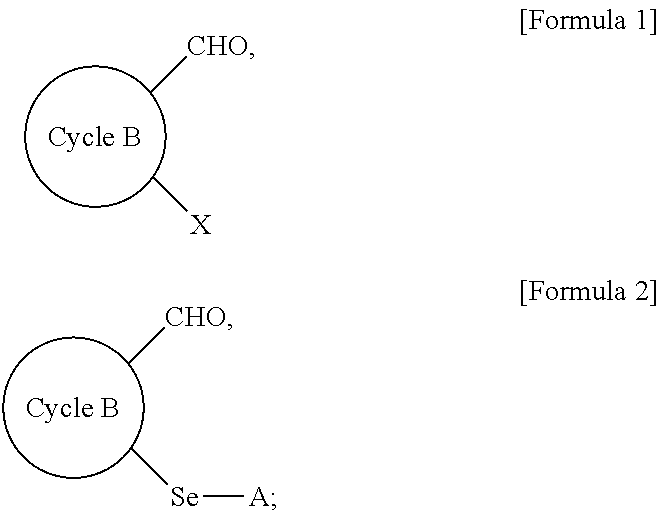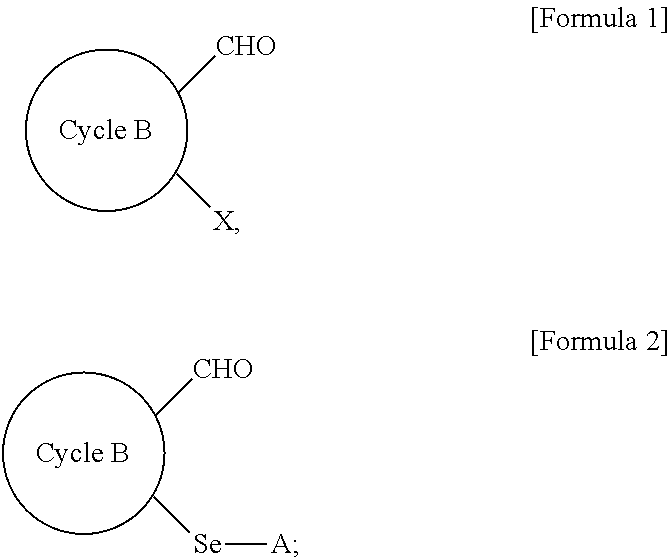Method for preparing selenyl-substituted aromatic aldehyde compounds
a technology of aromatic aldehyde and substituted selenyl, which is applied in the field of selenyl can solve the problems of difficult to obtain selenyl-substituted aromatic aldehyde compounds by the above-described conventional methods, and most of these catalystic processes need to be carried out under harsh reaction conditions, so as to achieve easy handling, increase the yield of selenyl-
- Summary
- Abstract
- Description
- Claims
- Application Information
AI Technical Summary
Benefits of technology
Problems solved by technology
Method used
Image
Examples
experimental example 1
[0097]
[0098]In Experimental Example 1, dimethyldiselenide (DMDS, MeSeSeMe) was used as the diselenide compound, and 5-nitro-2-chloro-benzaldehyde was used as the aromatic aldehyde starting material to prepare 2-methylselenyl-5-nitro-benzaldehyde as shown in the above reaction formula. The other materials, i.e. the solvent, the reducing agent, and the base, were not limited in kind and various kinds thereof were used for the experiment. Differences in % yield of the product caused by such differences in reaction conditions are shown in the following Table 1:
[0099]
TABLE 1ReducingDMDSagentTimeTemp.ProductEntry(eq.)(eq.)Base(eq.)Solvent(h)(° C.)(% yield)11NaBH4 (1)NaOEtEtOH5600(ComparativeExample)22NaBH4 (2)—EtOH24Room3(ComparativetemperatureExample)(RT)32NaBH4 (2)—DMF24RT5(ComparativeExample)41NaBH4 (1)—THF6600(ComparativeExample)51—K2CO3DMF14 0—(Comparative(2.5)Example)61DTT (1)NaOEt (2)EtOH4RT85(Example)71DTT (2)NaOEt (2)DMF1RT85(Example)81.2DTT (1)K2CO3DMF1RT85(Example)(2.5)91.2DTT ...
experimental example 2
[0103]
[0104]In Experimental Example 2, dimethyldiselenide (DMDS, MeSeSeMe) was used as the diselenide compound, and 4,5-methylenedioxy-2-bromo-benzaldehyde was used as the aromatic aldehyde starting material to prepare 4,5-methylenedioxy-2-methylselanyl-benzaldehyde as shown in the above reaction formula. The other materials, i.e. the solvent, the reducing agent, and the base, were not limited in kind and various kinds thereof were used for the experiment. Differences in % yield of the product caused by such differences in reaction conditions are shown in the following Table 2:
[0105]
TABLE 2EntryReducingBaseDMDSTimeTemperatureProduct(Example)agent(eq.)(eq.)Solvent(eq.)(h)(° C.)(% yield)1DTT (1)NaOEtEtOH124RT—(2)2DTT (1)NaOEtDMF124RT—(2)3DTT (1)NaOEtDMF12460—(2)4DTT (1)DBU (2)DMF11RT805DTT (1)DBUDMF1.21RT82(2.5)6N-DBUDMF1.53RT56acetylcysteine(2.5)(2)71,4-DBUDMF1.53RT60butanedithiol(2.5)(2)
[0106]As can be seen from Table 2, for Entry 1 to Entry 3, dithiothreitol (DTT) was used as the r...
experimental example 3
[0110]In Experimental Example 3, dithiothreitol (DTT) was used as the reducing agent and dimethylformaldehyde (DMF) was used as the solvent to prepare a selenyl-substituted aromatic aldehyde compound. The diselenide compound as represented by general formula A-Se—Se-A, the aromatic aldehyde starting material, and the base were not limited in kind and various kinds thereof were used for the experiment.
[0111]To be specific, as the diselenide compound, dimethyldiselenide having a methyl group (Me) as the functional group A, diphenyldiselenide having a phenyl group (Ph) as the functional group A, or dibenzyldiselenide having a benzyl group (Bn) as the functional group A was used. As the aromatic aldehyde starting material, various aromatic aldehyde materials having an electron donating substituent or an electron withdrawing substituent were used. Formulas thereof are provided in the following Table 3. Further, as the base, K2CO3 as a weak base or DBU as a strong base was used. In all ca...
PUM
| Property | Measurement | Unit |
|---|---|---|
| temperature | aaaaa | aaaaa |
| temperature | aaaaa | aaaaa |
| temperature | aaaaa | aaaaa |
Abstract
Description
Claims
Application Information
 Login to View More
Login to View More - R&D
- Intellectual Property
- Life Sciences
- Materials
- Tech Scout
- Unparalleled Data Quality
- Higher Quality Content
- 60% Fewer Hallucinations
Browse by: Latest US Patents, China's latest patents, Technical Efficacy Thesaurus, Application Domain, Technology Topic, Popular Technical Reports.
© 2025 PatSnap. All rights reserved.Legal|Privacy policy|Modern Slavery Act Transparency Statement|Sitemap|About US| Contact US: help@patsnap.com



